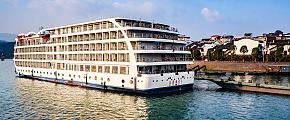The Three Gorges - the Highlight of Yangtze River
The Three Gorges Scenic Spot was named after the Qutang, Wuxia, and the Xiling gorges. Located in Hubei Province these three gorges are over 193 kilometers long and cover an area of over 1208 square kilometers. They begin at Baidicheng, Chongqing, and end at Nanjin Pass in Yichang. Due to its magnificent scenery, the Three Gorges has been a source of inspiration for poets and artists, and one of the hottest tourist destinations for centuries. It was designated one of the first Key National Scenic Spots by the Chinese government in 1982. The Three Gorges Scenic spot contains many different ecological environments and has abundant species of wildlife. In the Three Gorges area over 570 species of vertebrates have been documented, and many Biologists believe that there are many more yet undiscovered. Two of which have been listed as National Class 1 Protected Wild Animals. Nine different species have been listed as National Class II Protected Wild Animals, and two have been listed as National Class III Protected Wild Animals.
This area is one of the earliest tourist destinations in China. Li Daoyuan (472-527 AD), a geographer made a detailed investigation of the Three Gorges over fourteen hundred years ago and gave detailed descriptions of the Three Gorges in his treatise. Many ancient officials, poets, and painters have visited the Three Gorges area for many centuries. Each was deeply touched by the beautiful scenery and many of their paintings and poems featuring the Three Gorges have survived.
The Three Gorges has a long history. Recent archaeological studies have discovered that the Damiao culture was in the area over 2 million years ago. The area's most well-known ancient civilization the Daxi had built thousands of graves in the Three Gorges area over 5,000 years ago. A large number of artifacts have recently been unearthed giving us a better understanding of this ancient culture. To date, 2830 ancient graves have been discovered in the Three Gorges area. One of the most famous ancient features of the Three Gorges area is the suspended coffins. These coffins were suspended on the cliff faces 120 to 150 Meters above the ground. Archaeologist theorizes that these suspended coffins were built during the late Western Han Dynasty (206 BC–9 AD) to the early Eastern Han Dynasty (25–220 AD). How these ancient people got the coffins to such an inaccessible place has remained a mystery for centuries. A visit to the Three Gorges area is a must for any visitor to China. Whether you are a lover of natural beauty or a student of history this is an area that will leave you spellbound. The only way to visit the three gorges is through a boat tour since most of the Three Gorges area is inaccessible by foot.
 Yangtze Cruise
Yangtze Cruise
Five Stage Ship Lock
The Three Gorges Dam's Five Stage ship lock can raise, or lower ships to cross the Three Gorges Dam. Essentially it is a giant ship elevator. It is capable of lifting a passenger line, or cargo ship of 14,000 tons to a maximum height of 113 meters.
Wuxia Gorge
Wuxia Gorge is the longest of the three gorges at over 42 kilometers long. It is famous for its deep valley, and soaring peaks mountain peaks rising from the river's banks. It is a serene and secluded place that presents a panorama of lovely scenery. Within Wuxia Gorge are eight famous natural scenes, and twelve famous peaks.
Xiling Gorge
Xiling Gorge is 66 kilometers long and is well-known for its dangerous rugged shoals and turbulent waters. The mountain peaks in Xiling Gorge rise straight out of the river each one appearing higher than the previous. Located in this gorge are strange peaks and peculiar rock formations. Karst caves can be found everywhere. There are over 170 documented caves in this gorge alone.
Qutang Gorge
Qutang Gorge is 8 kilometers long making it the shortest among the three gorges. At the Western entrance, the sharp cliffs rise hundreds of meters on both sides of the longest river in China, the Yangtze River. An ancient narrow footway that meanders around the steep cliffs follows the river through the gorge. This footpath was built during the Qing Dynasty (1644-1911) using manpower and the simplest tools. Its width ranges from only 0.4 to 1.5 meters with nothing below but the swirling turbulent waters.
What Our Clients Say
"Great Customized Service", "Trip of A Lifetime", "Exceed All Expectations"





